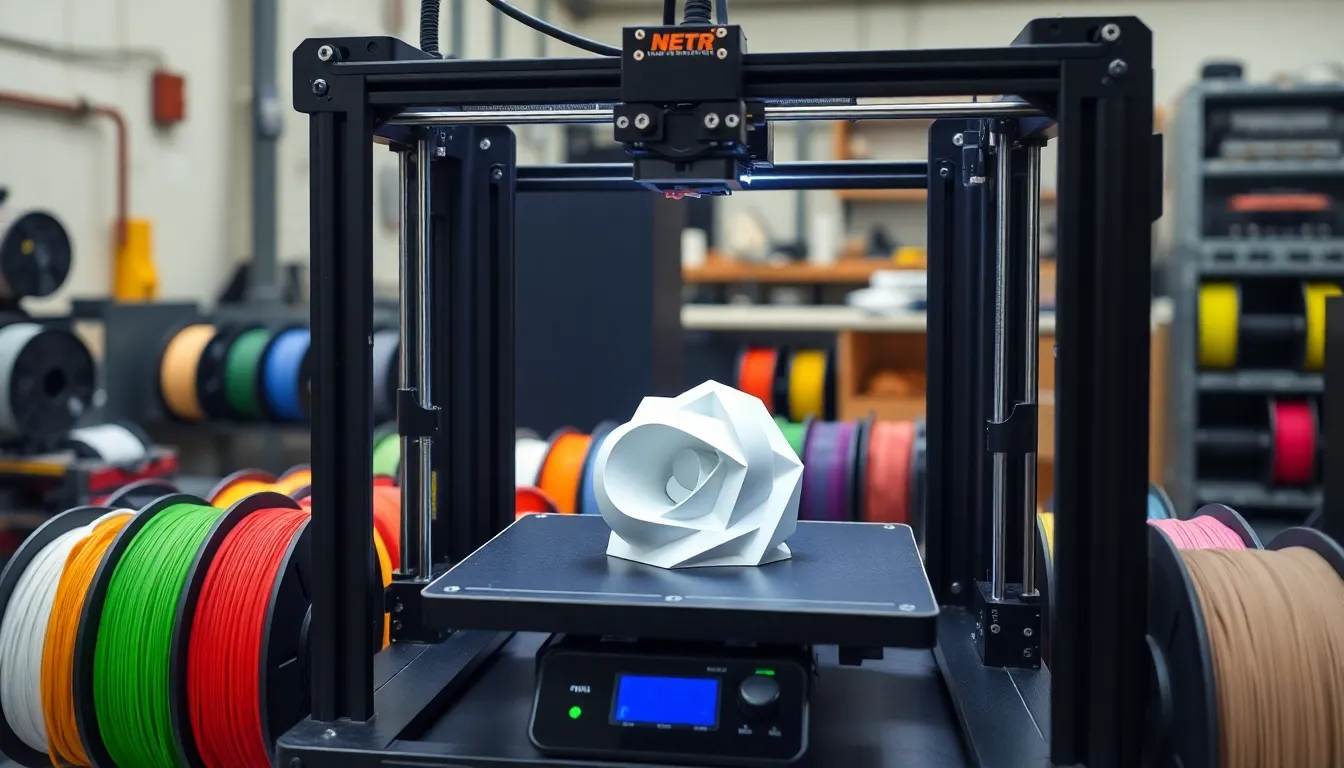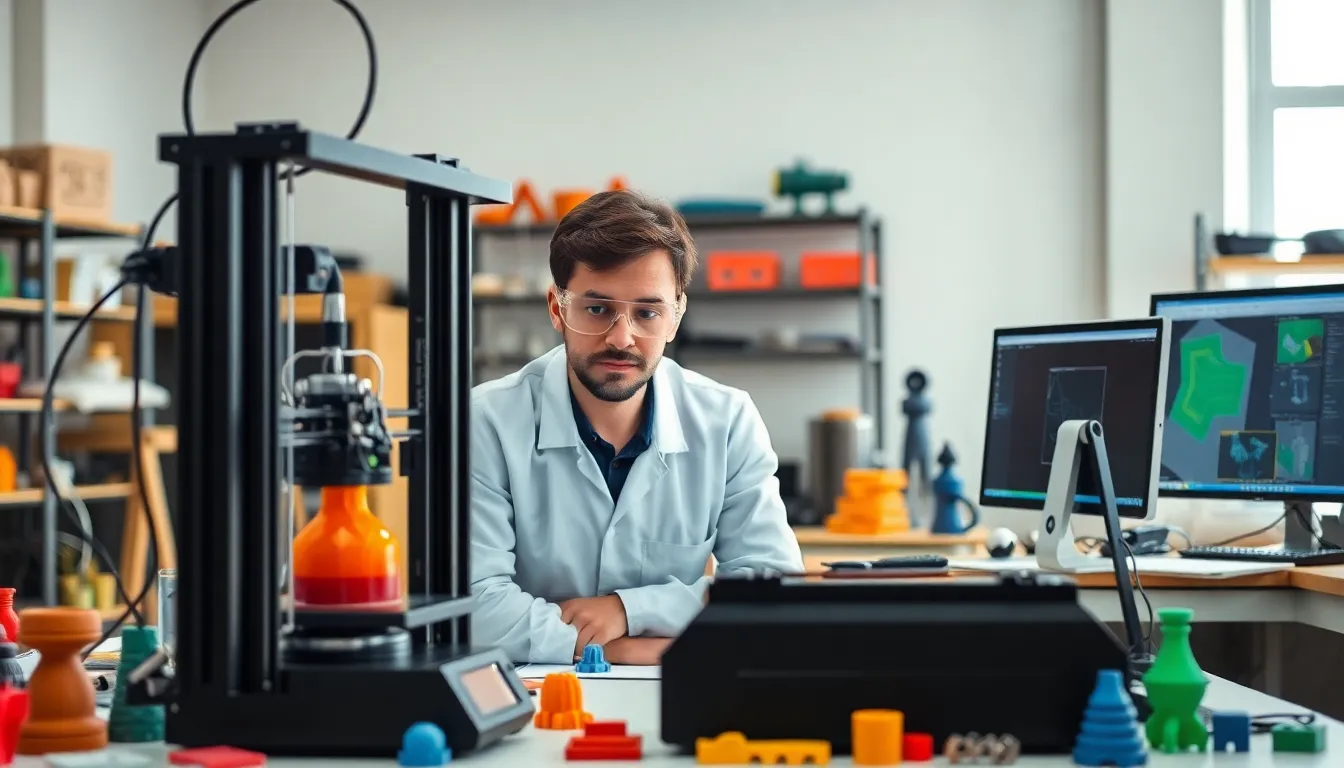In a world where the only limit to creativity is the size of your imagination, 3D printing stands as the ultimate game-changer. Gone are the days of traditional manufacturing headaches. Now, anyone can whip up a prototype faster than you can say “layer by layer.” But before diving headfirst into the realm of 3D design, there are some essential tricks to keep in mind.
Table of Contents
ToggleUnderstanding 3D Printing Technology
3D printing technology revolutionizes how designs come to life. It transforms digital concepts into tangible objects through various methods.
Types of 3D Printing
Fused deposition modeling (FDM) employs a thermoplastic filament that melts to create layers. Stereolithography (SLA) uses a laser to cure liquid resin into solid forms, achieving high detail. Selective laser sintering (SLS) employs a laser to fuse powdered materials, perfect for complex geometries. Digital light processing (DLP) delivers speed and precision by using a digital light projector to cure resin. Each type serves unique purposes, allowing designers to choose based on their project requirements.
Applications of 3D Printing
3D printing finds extensive use in diverse fields. In healthcare, it produces custom prosthetics and implants tailored for individuals. The automotive industry relies on 3D printing for prototyping components, reducing costs and production time. Aerospace companies benefit from lightweight parts that enhance fuel efficiency. Additionally, the construction sector uses 3D printing for building structures with minimal waste. Such applications underscore the technology’s flexibility and efficiency across various industries.
Key Principles of 3D Design

3D design encompasses crucial principles that enhance printability and material usage. Designers must consider these aspects to ensure successful outcomes.
Designing for Printability
Printability hinges on understanding how a 3D printer operates. Objects should feature stable geometry, minimizing overhangs and maximizing surfaces in contact with the build plate. Orienting parts correctly during printing helps maintain structural integrity. Avoid intricate details that printers may struggle to reproduce effectively. Ensure design incorporates proper support structures for complex shapes. Lastly, consider using fillets or rounding corners to prevent stress concentrations and potential failure during the printing process.
Material Considerations
Selecting the right material significantly impacts both the functionality and aesthetic of the final product. Thermoplastics like PLA and ABS remain popular due to their versatility and ease of use. Additionally, each material category presents unique properties, such as flexibility, temperature resistance, or strength. Understanding these characteristics informs designers about suitable applications for their creations. For projects requiring durability, materials like nylon or PETG may be applicable. Make sure to factor in print conditions, like bed adhesion and warping tendencies, that vary by material, to enhance printing success.
Software and Tools for 3D Design
Choosing the right software and tools for 3D design significantly impacts the quality of the final product. Numerous options exist, catering to a variety of skills and project needs.
Popular Design Software
Blender, a robust open-source tool, offers extensive features for modeling, animation, and rendering. Fusion 360, tailored for both beginners and experts, integrates CAD, CAM, and CAE capabilities. Tinkercad simplifies the design process with its intuitive interface, making it suitable for educational purposes. SketchUp, known for its ease of use, suits architectural designs and quick prototyping. SolidWorks, while powerful, is often preferred by professionals for its advanced simulation and design functions.
Hardware Requirements
Selecting adequate hardware ensures a smooth design experience. A dedicated graphics card enhances rendering performance, critical for complex models. Sufficient RAM, preferably 16GB or more, facilitates multitasking and handling large files. A fast processor accelerates calculations, ensuring efficient design adjustments. Choosing a monitor with high resolution helps visualize finer details during the design process. Storage space, ideally on an SSD, reduces load times, making the overall experience more productive.
Best Practices for 3D Printing Design
Effective 3D printing design involves specific practices that enhance model quality and printing efficiency. Following these guidelines maximizes the potential of 3D printing technology.
Optimizing Your Models
Model optimization is critical for successful 3D printing. Simplify complex designs to reduce issues during printing. Ensure that wall thickness varies appropriately; thinner sections may not print well. Create features like fillets and chamfers to enhance structural integrity. Incorporate a design for manufacturability approach, which helps in producing parts that align with printing capabilities. Consider the intended use when selecting dimensions, as appropriate scaling impacts functionality. Furthermore, ensure that your models are manifold and free of non-manifold edges, as these prevent successful slicing in printing software.
Testing and Iteration
Testing and iteration are essential steps before finalizing designs. Run small print tests to identify issues early, saving time and resources. Evaluate print results to uncover areas needing adjustments, such as support structures or orientation changes. Regular feedback from prototype iterations informs design improvements, leading to better functionality and aesthetics. Collaborating with users during this process also yields valuable insights. Adjustments based on testing enhance the overall print quality, ensuring that the final product meets specifications. Engaging in this iterative approach creates a more refined end result, improving both design and printing processes.
Common Mistakes to Avoid
Avoiding common pitfalls enhances the success of 3D printing projects. Several mistakes frequently occur during the design process, impacting functionality and print quality.
Overcomplicated Designs
Overcomplicated designs can pose significant challenges. Complexity often leads to issues during printing. Maintaining simplicity enhances success rates. Designs with too many intricate details make prints more difficult and time-consuming. Choosing to incorporate essential features while limiting unnecessary elements increases both printability and overall effectiveness. Adopting a minimalist approach may yield superior results. Combining different shapes, instead of adding excessive detail, often simplifies the creation process. Testing designs prior to final production helps identify potential complications.
Ignoring Printer Limitations
Ignoring printer limitations frequently results in failed prints. Every 3D printer has specific capabilities, including maximum size, layer resolution, and supported materials. Understanding these restrictions is crucial. Focusing on achievable designs can lead to better outcomes. Altering designs to fit the printer’s specifications often improves success. Assessing the printer’s technical manuals helps designers make informed decisions. Choosing appropriate features that align with the printer’s capabilities leads to higher quality and a smoother printing process. Avoiding designs that push the printer beyond its limits will save time and reduce frustration.
Embracing the world of 3D printing opens up endless possibilities for creativity and innovation. With the right design principles and an understanding of the technology, anyone can create functional and aesthetically pleasing objects.
Choosing the appropriate materials and software is crucial for achieving high-quality results. By prioritizing simplicity and optimizing designs, individuals can enhance their printing success and minimize common pitfalls.
As 3D printing continues to evolve, staying informed about advancements and best practices will empower designers to push the boundaries of what’s possible. With dedication and practice, the journey into 3D design can lead to remarkable achievements in various fields.




